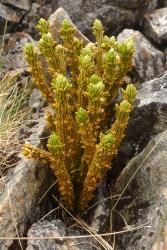- = Urostachys Herter, Beih. Bot. Centralbl. Abt. 2, 39: 249 (1922)
Terrestrial plants. Stems erect, dichotomously branched, with branches of equal thickness, lacking horizontal stems. Roots arising from the stem stele and descending through the cortex to the stem base, forming a single basal tuft. Leaves spirally arranged, all similar; leaf margins entire or minutely toothed at the apex. Bulbils present in axils of some leaves. Sporophylls similar to the leaves, not aggregated into distinct strobili, persistent. Spores foveolate or fossulate, triangular in polar view with concave lateral margins and truncate corners, and foveolate sculpture on both proximal and distal faces.
A genus of 25 species (PPG 1 2016).
The huperzioid clade within Lycopodiaceae includes three distinct genera: Huperzia, Phlegmariurus and Phylloglossum (Field et al. 2016). However, under earlier classifications Huperzia was more broadly circumscribed to include two of those genera, Huperzia and Phlegmariurus (Øllgaard 1987), or all three (Christenhusz et al. 2011). New Zealand species of Huperzia and Phlegmariurus were treated in Lycopodium by Allan (1961).
The huperzioid clade is distinguished by isotomous branching, with all dichotomies resulting in equally thick branches; roots arising from the stem stele and descending through the cortex to the stem base, forming a basal tuft; sporophylls that are either similar to the leaves, or modified, aggregated into strobili and persistent (Øllgaard 1987, 1990; Field et al. 2016); and with foveolate or fossulate spores (Tryon & Lugardon 1991, figs 227.1–227.14; Large & Braggins 1991).
Huperzia is distinguished from Phlegmariurus by bearing reproductive bulbils in the leaf axils (Øllgaard 1987, fig. 22), having sporophylls that are not aggregated into strobili, and producing distinctive spores that are triangular in polar view with concave, lateral margins and truncate corners, and foveolate sculpture on both proximal and distal faces (Tryon & Lugardon 1991, figs 227.1–227.3). They are typically small, terrestrial plants (Field et al. 2016). Huperzia is also easily distinguished from Phylloglossum, which is a tiny terrestrial plant with a subterranean tuber, a whorl of linear leaves, and a small strobilus borne on a leafless stalk.
Huperzia is a genus of 25 species, mostly occurring in forests and alpine habitats of the north temperate region, but with some representatives in high-altitude tropical floras, and a very few in the south temperate zone (Field et al. 2016); one, or possibly two, species in Australia (Chinnock 1998; Field & Renner 2019). One indigenous, non-endemic species in New Zealand.
| Category | Number |
|---|---|
| Indigenous (Non-endemic) | 1 |
| Total | 1 |
Chromosome numbers in Huperzia s.s. vary from 2n = 90 to 2n = over 400. A common base number is x = 11, but there are many exceptions (Field et al. 2016).
Many of the species now placed in Huperzia and Phlegmariurus were previously included in Urostachys. However, the type of Urostachys is Lycopodium selago L., now in Huperzia, and hence Urostachys is a synonym of Huperzia, not Phlegmariurus.




